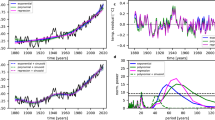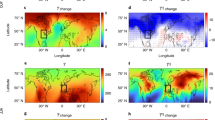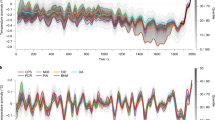Abstract
Lockwood et al.1 recently presented some intriguing new evidence of solar variability, but Parker's accompanying News and Views article2 gave an exaggerated and misleading picture of the potential effects on terrestrial climate. This picture is at variance with both the evidence3 and a public statement by Lockwood himself, reported in ref. 4.
Similar content being viewed by others
Main
As Parker mentions, the only available direct measurements show a variation of just 0.15% in solar irradiance S over one solar magnetic cycle of 11 years. Greater variations on longer timescales are possible, but other reports5,6 give figures that are less than the 0.5% that Parker quotes. Even ΔS/S≈0.5% implies global mean radiative forcing: (ΔS/4)(1−α)≈1 W m−2, where α≈0.3 is Earth's albedo. For comparison, the Intergovernmental Panel on Climate Change (IPCC) estimates the change in global mean radiative forcing from 1861 to 1990 as 2.0 to 2.8 W m−2 from greenhouse gases, −0.2 to −2.3 W m−2 from aerosols, and 0.1 to 0.5 W m−2 from solar variability7,8. There has been much speculation about additional solar effects but, with regard to Parker's remark about cosmic-ray effects on clouds, we note that the cited work9 claims that this effect would only amplify solar radiative forcing to less than 2 W m−2.
We are surprised by Parker's suggestion that solar brightening is responsible not only for the observed increase in twentieth-century surface temperatures, but also for increased carbon dioxide in “the same way that a carbonated drink expels most of its CO2 if warm”. Given the observed surface temperature increase of about 1 K, a simple calculation10 reveals that this effect would increase equilibrium CO2 by less than 5%, which is much less than the 30% increase recorded since the beginning of the industrial revolution. Records of 13C and 14C isotopes relative to 12C also support the idea that changes in atmospheric CO2 are primarily due to the burning of fossil fuel8.
Although solar effects on this century's climate may not be negligible, quantitative considerations imply that they are small relative to the anthropogenic release of greenhouse gases, primarily carbon dioxide. Figure 8.4 of the IPCC 1995 assessment report3 (also shown in refs 7, 11) makes that point clearly, even though it assumes solar variability near the upper end of its uncertainty range7.
On longer timescales, it is not a “historical fact” that climate “responds to variations of the Sun's magnetic activity, with substantial warming and cooling with the rise and fall of activity over the centuries”. Several recent palaeoclimate compilations12,13 indicate only that weak responses to putative solar variations have occurred over the past 500–1,000 years. The data suggest that global mean temperatures during the 1990s may have been the warmest of the millennium. Together with climate model simulations (which, contrary to Parker, quantify the combined effects of cloud, winds, ocean currents, solar effects and anthropogenic effects14,15,16, however imperfectly), the data indicate that there is probably a strong anthropogenic component to twentieth-century global warming.
References
Lockwood, M., Stamper, R. & Wild, M. N. Nature 399, 437–439 (1999).
Parker, E. N. Nature 399, 416–417 (1999).
Santer, B. D. et al. in Climate Change 1995: The Science of Climate Change (eds Houghton, J. T. et al.) 406–443 (Cambridge Univ. Press, 1996).
Pearce, F. New Scientist p. 5 (5 June 1999).
Lean, J., Skumanich, A. & White, O. Geophys. Res. Lett. 19, 1591–1594 (1992).
Hoyt, D. V. & Schatten, K. H. J. Geophys. Res. 98, 18895–18906 (1993).
Harvey, L. D. D. et al. An Introduction to Simple Climate Models used in the IPCC Second Assessment Report, IPCC Technical Paper II (WMO, Geneva, 1997).
Schimel, D. et al. in Climate Change 1995: The Science of Climate Change (eds Houghton, J. T. et al.) 65–139 (Cambridge Univ. Press, 1996).
Svensmark, H. & Friis-Christensen, E. J. Atmos. Terrest. Phys. 59, 1225–1232 (1997).
Walker, J. C. G. Numerical Adventures with Geochemical Cycles (Oxford Univ. Press, 1991).
Covey, C. & Hoffert, M. I. Clim. Change 37, 387–390 (1997).
Mann, M. E. & Bradley, R. S. Geophys. Res. Lett. 26, 759–762 (1999).
Briffa, K. R. & Osborn, T. J. Science 284, 926–927 (1999).
Cubasch, U. et al. Clim. Dynam. 13, 757–767 (1997).
Wigley, T. M. L., Smith, R. L. & Santer, B. D. Science 282, 1676–1679 (1998).
Tett, S. F. B. et al. Nature 399, 569–572 (1999).
Author information
Authors and Affiliations
Rights and permissions
About this article
Cite this article
Hoffert, M., Caldeira, K., Covey, C. et al. Solar variability and the Earth's climate. Nature 401, 764 (1999). https://doi.org/10.1038/44519
Issue Date:
DOI: https://doi.org/10.1038/44519
This article is cited by
-
Solar Forcing of Global Temperature Change Since AD 1400
Climatic Change (2005)
Comments
By submitting a comment you agree to abide by our Terms and Community Guidelines. If you find something abusive or that does not comply with our terms or guidelines please flag it as inappropriate.



